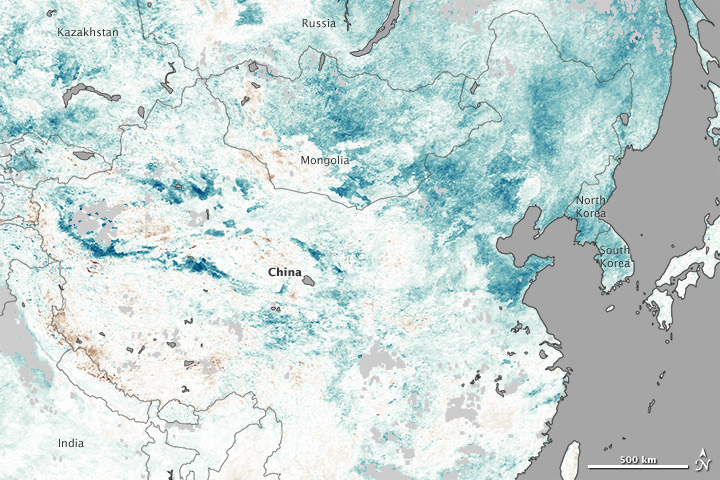


Between late November 2012 and early January 2013, China recorded its lowest temperatures in 28 years. In northeastern China, air temperatures dipped to -15.3°Celsius (4.5°Fahrenheit), according to the state news agency Xinhua. Frigid temperatures and blizzards stranded air and rail passengers, killed roughly 180,000 cattle, and forced authorities to open hundreds of shelters.
China’s cold air temperatures were mirrored by low land surface temperatures (LSTs), or how much infrared energy is emitted by the planet’s surface. This map shows LST anomalies—departures from average temperatures—for January 1–8, 2013. The 2013 readings were compared to temperatures for the same dates from 2001 to 2011. The LSTs were compiled from observations by the Moderate Resolution Imaging Spectroradiometer (MODIS) on NASA’s Terra satellite.
LSTs are sometimes referred to as land “skin” temperatures, and they are a reflection of how hot a surface would feel to the touch. (To learn more about LSTs and air temperatures, read: Where is the Hottest Place on Earth?) In the map, above-normal temperatures appear in shades of red, and below-normal temperatures appear in shades of blue. The darker the color, the greater the anomaly. Gray indicates water or areas with insufficient data (often due to cloud cover).
Despite isolated patches of warmer-than-usual temperatures (especially along the borders of India and Nepal), below-average temperatures dominated at the beginning of 2013, including areas of intense cold in western and northeastern China, Mongolia, Russia, and the Korean Peninsula. Frigid conditions froze part of the Yellow River and trapped roughly 1,000 ships in Laizhou Bay, news sources said.
Although cold temperatures were most severe in northern China, many of the emergency shelters were opened in southern China, where residents had fewer resources to heat their homes, USA Today reported. In northeastern China, the increased need to burn fuel likely contributed to China’s severe air pollution in January 2013.
NASA Earth Observatory image by Jesse Allen, using data from the Land Processes Distributed Active Archive Center (LPDAAC). Caption by Michon Scott.